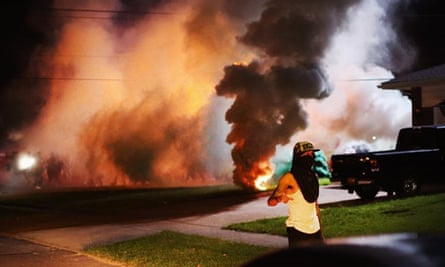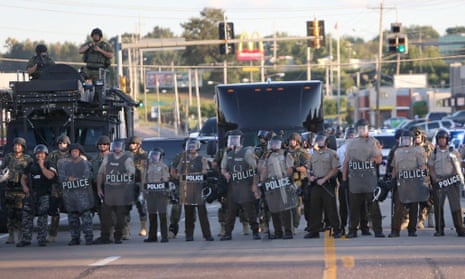Michael Brown was shot dead by an officer from a police force of 53, serving a population of just 21,000. But the police response to a series of protests over his death has been something more akin to the deployment of an army in a miniature warzone.
Ferguson police have deployed stun grenades, rubber bullets and what appear to be 40mm wooden baton rounds to quell the protests in a show of force that is a stark illustration of the militarization of police forces in the US.
“I’m a soldier, I’m a military officer and I know when there’s a need for such thing, but I don’t think in a small town of 22,000 people you need up-armor vehicles,” Cristian Balan, a communications officer in the US army, who was not speaking on behalf of the US military, told the Guardian. “Even if there’s an active shooter – are you really going to use an up-armor vehicle? Do you really need it?”
In the eyes of the government, the answer increasingly seems to be a resounding yes.
Since 2006, state and local law enforcement have acquired at least 435 armored vehicles, 533 military aircraft and 93,763 machine guns, according to an investigation by the New York Times published in June. This was made possible under a department of defense program that allows the agency to transfer excess military property to US law enforcement agencies. More than $4.3bn worth of gear has been transferred since the program was created in 1997, according to the Law Enforcement Support Office (LESO).
The ACLU said there are no “meaningful constraints” to what a local police force could acquire, meaning that even a 10,000 person town with no history of major violence could request and receive a mine-resistant vehicle, like those that are currently available on the LESO site.

Forced to address the issue at a Pentagon briefing on Thursday, spokesman Read Admiral John Kirby said that while the government made such equipment available in a “useful” program, it was up to local agencies to decide how to use it. “I’m not going to inject the Pentagon into this discussion,” he said. “How this equipment is used to serve local citizens is up for local law enforcement agencies to speak to.”
The increasing militarization of US police is also attributed to the skyrocketing proliferation of Swat teams across the US. There has been a more than 1400% increase in the amount of Swat deployments between 1980 and 2000, according to estimates (pdf) by Eastern Kentucky University professor Peter Kraska.
The police presence in Ferguson has centred around two large armoured trucks ferrying around officers in military-style uniforms. Officers wearing body armour and holding sniper-style rifles have been positioned atop them. Some have adorned night-vision goggles as the evenings grew darker.

Accompanying the trucks have been hundreds of officers from various forces from around the region. Some state troopers and county police officers have been kitted out in basic riot gear – shields, batons and helmets with visors – along with their standard handguns and plastic cuffs.
Others, whose affiliations are not made clear by their uniform, have been carrying what look like AR-15 assault rifles. They wear helmets and all-black body armour, some with partial urban camouflage.
On Wednesday evening, some such officers were carrying 12-gauge shotguns and “super-sock” bean-bag cartridges for shooting at protesters. Protesters have also been fired on with 60-calibre Stinger rubber bullets and what appear to be 40mm wooden baton rounds. Mini “flashbang” stun grenades, which are used by the US army to disorient combatants, have also been deployed.
But the most alarming sight for many protesters and residents has been the deployment of officers wearing army-style fatigues distinguished only from the military version by the word “POLICE” emblazoned in grey across their chest. Some have been carrying grenade launchers,apparently for shooting gas canisters. The remains of “triple chaser” grenades have been found on the streets. Others have carried paintball-style guns for shooting pepperballs.

“As we’ve seen in Ferguson, the militarization of policing tends to escalate the risk of violence to the communities,”said Kara Dansky, senior counsel with the ACLU’s Center for Justice and the prime author of its June 2014 report on the militarization of US police. “We think that historically, the police and the military have had different roles and that American neighborhoods aren’t war zones and police officers should not be treating us like wartime enemies.”
She said the trend of militarizing local police forces has continued over the past several decades and that communities of color bare the brunt of most military policing.
Representative Hank Johnson, a house Democrat from Georgia, said on Thursday that he plans to introduce the “Stop Militarizing Law Enforcement Act”, which would end the department of defense’s military surplus program.

Comments (…)
Sign in or create your Guardian account to join the discussion